My mother developed Parkinson’s Disease (PD) over 22 years ago. My mom’s brother passed away from PD, and another relative on the maternal side also suffered with it. I also have a more distant “uncle” who is in the early stages of PD, who I visit. This particular disease has loomed large in my family and my life for over two decades, but many of its challenges and what helps will apply to those living with other diseases and their caregivers. In this blog post I would like to share how the Gokhale Method has helped my mom, my family, and me.
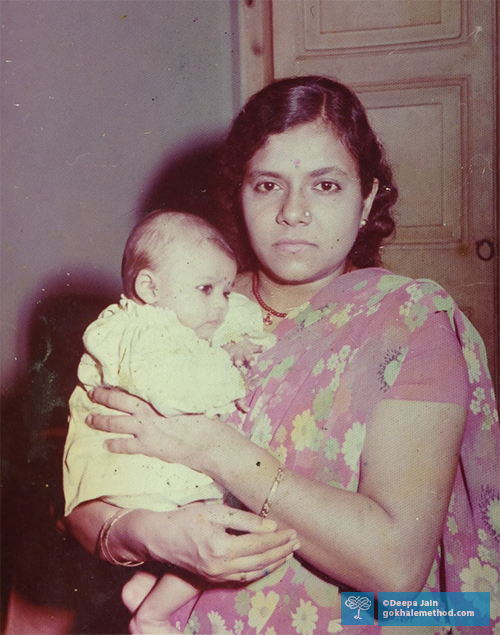
Here is my mom—I am the baby in her arms.

And here we are together in more recent times. My Mom had just danced a few steps of a traditional Gujarati folk dance. She was always among the first on the dance floor.
Parkinson’s disease and posture
The symptoms of PD vary from person to person, but common physical symptoms are tremors in the hands, arms, jaw, or head, rigidity where muscles remain contracted, slowness of movement, slower visual processing, and impaired balance and coordination. These all impact a person’s posture and movement, which typically becomes stooped and shuffling.
In 2012 my mom had deep brain stimulation surgery to help improve connections in the brain synapses. She also has well-managed medication.
It seemed to me that with access to learning baseline healthy posture, my mom would be in a much better place to counter the typical head forward, shoulders rounded posture that accelerates in PD.
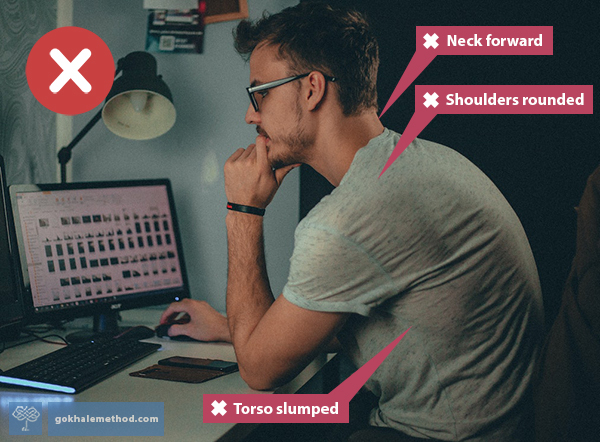
Hunched, rounded posture is seen as normal in otherwise healthy people in our culture. Yet it compresses the chest and tightens the back of the neck, overstretches back ligaments, and weakens the deep postural muscles close to the spine. Pexels
Training in the Gokhale Method
With my mom’s situation foremost in my mind, I took the Gokhale Method Foundations Course with teacher Roberta Cooks in 2015. It was a light bulb moment when I realized nearly everyone in industrialized societies has lost touch with their natural, healthy posture, and that the Gokhale Method would like to see healthy posture accessed by all, not just those currently with back pain. This inclusive approach benefits the young and the old, the sick and the well, those actually in pain, those wanting to be more athletic, or those simply wanting to future-proof their structure.
Deteriorating posture was an early sign of my mom’s PD. Her head began to drop towards her chest and her gaze was downward. I found what I learned in the Gokhale Method about head position very useful in getting my mom to guide her head back and up, and I could help by confidently modeling healthy posture to encourage her.
I then wanted to acquire a Gokhale Method teacher’s skills of being able to analyze posture and adapt Gokhale Method techniques for the individual. My logical next step was to take teacher training with Esther Gokhale in Palo Alto. Through that I acquired a deeper understanding of posture in general, and my mom’s care in particular.
Managing the progression of Parkinson’s Disease
As my mom’s PD progressed, it was beyond useful to be able to match and apply the healthy posture techniques I had learned. Both for my mother and most others with PD, the sequence progression is head dropping towards the chest, shoulders rounding, tucking under of the pelvis, and then gait becoming short, shuffling, and hesitant. With my uncle, his pelvis tuck is now so pronounced he can’t sit upright on the sofa—but I do know how to use pillows to prop him up as vertically as possible, which is still of benefit to his spine, his internal organs, and is way more socially inclusive for him.
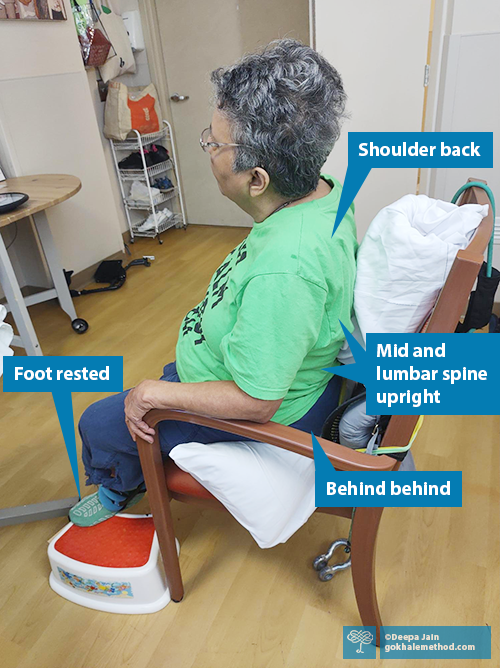
Like my uncle, my mom has benefitted hugely from judicious use of pillows and props that allows her to sit as upright as possible.
Sitting better brings better quality of life
For those afflicted with PD, the thoracic rounding inevitably gets worse and plays out in every position. I have seen that once the thoracic rounding is visible, a sideways lean is also not far behind.
With my posture knowledge combined with trial and error, I can get my mom into an approximate version of stacksitting. For example, I can help her antevert her pelvis, which is the foundation for the relaxed uprightness we are looking for. She cannot execute a shoulder roll, but she can rest her arms on armrests and slide her arms and shoulders back, which further contributes to bringing her more upright. This has huge benefits for her and is a game changer beyond my expectations. As with my uncle, she is more socially engaged with her face lifted, she has virtually no drooling, and can close her mouth and breathe easily through her nose.
One of my mom’s favorite activities since she went to an Ayurvedic (traditional Indian wellness modality) treatment clinic twelve years ago has been simple pranayama (breathing exercises). For the past eight years she hasn’t been able to do it following a video but is a huge fan when led in person. We have done this at least five times a week and she expresses joy in doing it. The Gokhale Method principles help enable much deeper inhales and exhales—we try as much as possible to have her shoulders back, her arms free from her torso, her back upright and palms resting upward on her wheelchair/chair armrest, with her head more upright. Like this she can see the trees and sky while we do her beloved "pranayama".
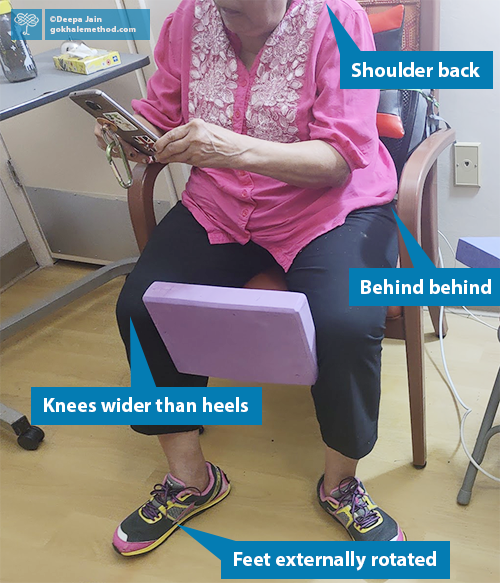
A simple foam block helps my mom practice sitting with her legs in healthy external rotation, keeping her pelvis better nestled and helping her to stack her spine.
I have eaten two meals a day with my mom for most of the last ten months. At this late stage, without props she will list to the side and suffer discomfort when sitting. When I get her to approximate a stacksit she chews better, swallows well, and there is less food spilled on her cloths and on the floor. It can be hard to manage the stacksitting because of the amount of maneuvering involved, but when I can do this for even one meal a day, everything is so much more golden for her.
Implementing what I have learned from the Gokhale Method has been profoundly helpful with her bathroom needs. For example, propping her up in her chair against the support of a video game pillow while flossing and brushing her teeth makes it easy for her to lean so she can open her mouth well, making her back teeth accessible.
Upright posture brings many health benefits
Parkinson’s patients benefit from the same posture goals as everyone else—avoiding as far as possible an S-shaped spine that deepens all the spinal curves and causes compression, and encouraging a lengthened J-spine.
Pneumonia is the primary cause of death for those with PD, for the stooped posture comes with a compressed chest and reduced mobility which exacerbates shallow breathing. So being able to regularly help my mom open her chest and breathe better by stacksitting has been key to maintaining her health.
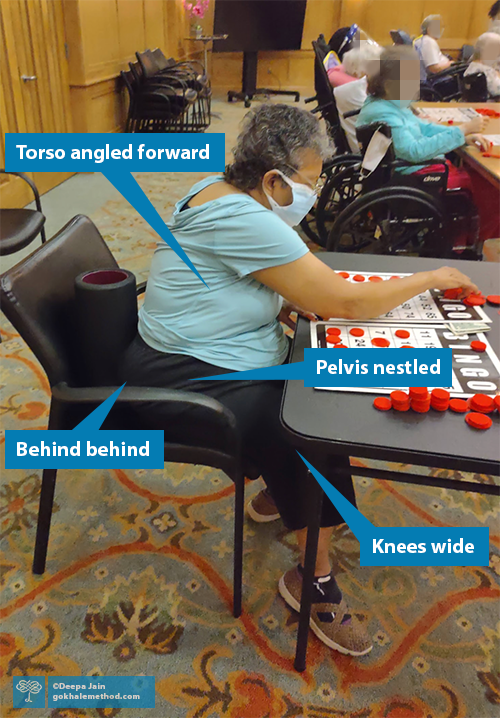
The “stickiness” of a Gokhale™ Method roller provides sacral support to prevent my mom’s pelvis from tucking and rounding her spine. Like this she can angle forward with a straighter spine to play games or eat.
Upright head carriage with a tall neck is a big challenge for people living with PD. In our culture, unlike in traditional societies that headload, the longus colli muscles are generally underworked and their importance underappreciated. They attach to the front of the cervical spine behind the throat and keep the neck upright, preventing forward head carriage. I suspect that healthy posture habits with the head and neck which naturally strengthen the longus colli would potentially help counter the excessive contraction of the more superficial muscles in the upper chest and neck area.
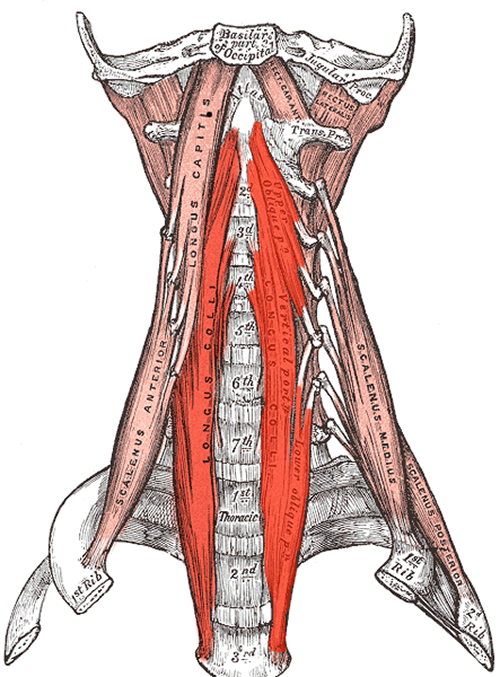
Strong longus colli muscles (shown in red) support the neck and project the delicate and vital structures within it, so we want to align it well. (front view). Wikipedia
Many PD physicians, PTs, and organizations¹ advocate working with posture to help maintain it for as long as possible. In my view, the more authentic the model of healthy posture is, the better the outcomes will be, and so the Gokhale Method is ideal for this undertaking.
The Gokhale Method, dance, and movement therapy
In my early twenties I discovered my passion for dance, and as a Gokhale Method teacher I have contributed dance videos to our Alumni Online University video library. The Gokhale Method has always recognized the potential for traditional dance in helping our students to pattern healthy movements and let go of old habits.
Here I show how a number of moves, once you have learned them, can be put together. This clip is from Arabic Hip Walk 2, one of the Gokhale Method Online University dance videos.
This is profoundly similar to the way that PD participants benefit from dance classes. My observation is based on volunteering for the Dance for PD® classes in New York City, a flagship program at the Mark Morris Dance Group. I helped certain participants get across the floor, and partnered others in mini-routines or provided additional support when needed. This gave me a broad exposure to a number of people with varying symptoms and degrees of symptoms of PD.
It seemed to me that the classes place an emphasis on opening postures and dance movements to boost the group members’ ability to relate to the space around them and counter the physical and emotional closing down that comes with PD.
The Gokhale Method, PD, and walking
Another area of crossover between the Gokhale Method and several movement therapies for PD is the teaching of walking. One of Esther’s favorite dance moves is a simplified Samba step, which teaches students to take weight through a strong, straight back leg and lighten the bent front leg—this a perfect component for helping posture students to find a healthy gait pattern for glidewalking.
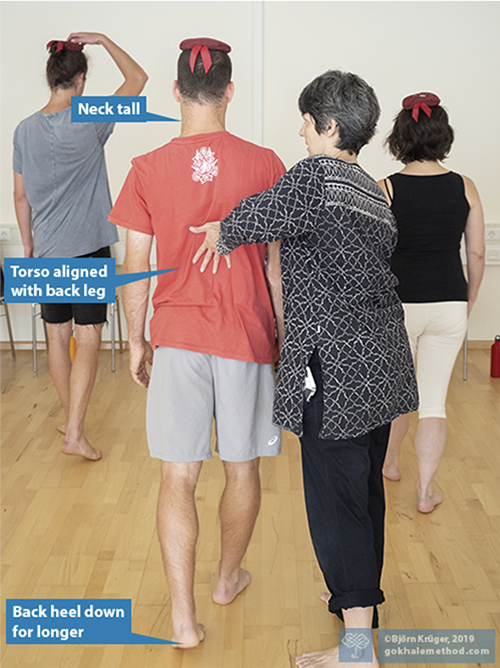
Most of us can benefit from some guidance on how to walk well, as in this Gokhale Method class. For those living with Parkinson’s, this is especially true.
This approach is not dissimilar from the techniques given by PTs to help people recapture a more measured, smooth gait that avoids the uncontrolled acceleration or shuffling associated with PD. Gokhale Method teachers are also skilled in gait analysis and offering particular drills—as well as dance steps—and know that even with cognitive impairment, people can improve by literally “going through the motions.”
In fact, for people living with PD it is generally best to keep moving doing any activity that suits them—otherwise it is safer to sit! Unfortunately, with PD, falls cause many injuries and deaths. Standing for more than a few minutes can be risky, especially if not leaning on or holding on to something. I think the most challenging part of standing is that it has no rhythm of any kind, and that sense of feeling balanced and coordinated by repeated alternating contact with the ground is missing.
Walking principles can be adapted for individual needs as they change. In this video from 2019 my mom benefits from a wider stance for stability, and leans on me for support and coordination to make small but regular steps.
The two years of lockdown measures during the pandemic certainly took their toll on my mom’s body, as sitting for over eight hours a day accelerated her knee osteoarthritis. I can now once more take her to my sister’s house where she can enjoy walking up a grassy slope barefoot to encourage her foot muscles to work. Being barefoot is familiar to her as she lived in Kolkata for 35 years of her life. Going down the slope, she does a grapevine-like step which encourages the alternation of bending and straightening the legs. After many months, we finally discovered an Indian folk song with an ideal waltz rhythm. Rehearsing this step also gives my mom a lot of mobility in other situations, such as navigating furniture where space is tight, or getting into bed without falling.
The transition from sitting to standing and vice versa
How to transition from sitting to standing has been taught to the elderly and others with mobility issues for many decades, by OTs, PTs and caregivers. It is often described as “nose over toes”—in the Gokhale Method we call a similar approach to bending “hip-hinging”. This is the most natural and biomechanically efficient approach to get in and out of sitting, and its elegance becomes even more useful when the legs and arms are too weak to muscle through any other way. It also allows a caregiver to give assistance without strain on their part. This maneuver has to happen so many times during the day it is worth getting it as right as possible.
Helping my mom to maneuver onto a tall chair. Once there, with her thighs angled down and her pelvis well nestled with her behind behind, she will be able to maintain an upright sitting position.
Helping family members and carers with the Gokhale Method
From my personal experience I am confident that family members of people living with PD would benefit from taking our in-person Foundations course, one-day Pop-up course, or our online Elements course as early as possible after their loved one’s diagnosis—as would professional carers. Even if I were not a teacher, as a student of this life-altering approach who had continued learning via the Online University, I firmly believe I would still be informed to take the measures that I have with my mom’s day-to-day living. Improving your own posture not only allows you to help others, but makes you more resilient and reduces any risk of injury in a caring role. Specific sessions with a Gokhale Method Teacher can also be very helpful with particular challenges.
Through my own knowledge and experience, I’m trying to be the change I want to see in terms of care for people in this situation, at home, in the community, and in care facilities. I am eager to learn more and while right now I am a busy carer for my mom, I would like to work with other people with PD in the future.
Thankfully, I do have support among the Gokhale Method Teacher community, where some teachers are also working with people with other movement disorders and conditions that can benefit, including ALS, Downs Syndrome, and Ankylosing Spondylitis.
Best next action steps for newcomers
If you would like insight on your posture, or how best to help someone you care for, consider scheduling an Initial Consultation, online, or in person.
You can sign up below to join one of our upcoming FREE Online Workshops. . .


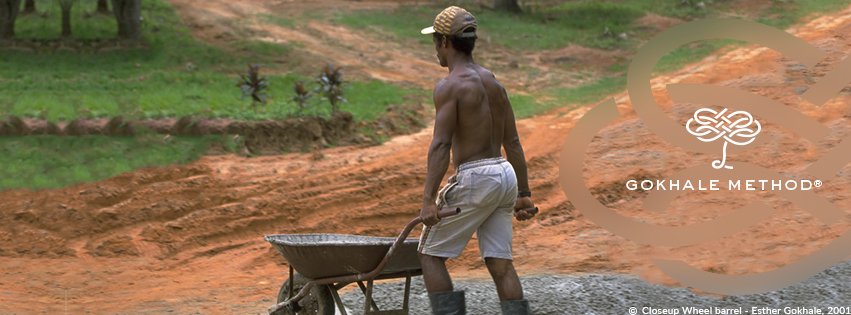
Comments
My husband was diagnosed of
My husband was diagnosed of Parkinson’s Disease a couple of years ago, he had severe fatigue, difficulty with mobility and sleeping. He was placed on Sinemet 3 times daily, which helped but only for a short while. So we decided to try alternative treatment and began on PD-5 protocol , It has made tremendous difference for my husband, he had improved walking balance, muscle strength and he is now very active. His Parkinson’s is totally under control, we got the treatment from binehealthcenter. com. This treatment is a breakthrough for PWP!
My husband was diagnosed of
My husband was diagnosed of Parkinson’s Disease a couple of years ago, he had severe fatigue, difficulty with mobility and sleeping. He was placed on Sinemet 3 times daily, which helped but only for a short while. So we decided to try alternative treatment and began on PD-5 protocol , It has made tremendous difference for my husband, he had improved walking balance, muscle strength and he is now very active. His Parkinson’s is totally under control, we got the treatment from binehealthcenter.com. This treatment is a breakthrough for PWP!